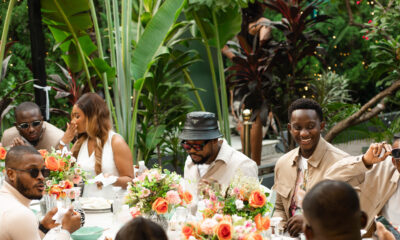Features
Kevin Monu: How to Make Long-Distance Marriages Work

Have you ever loved someone so deeply, yet life decided you both had to live in different cities or different countries? Anyone who has been or is in a long-distance relationship or marriage understands it’s not for the faint of heart. The time zones, the missed calls, the birthdays spent apart, and the hugs that never come when you need them most; it’s an emotional marathon.
Distance became both the greatest challenge and the greatest teacher for my wife, Sandra, and me. When work opportunities kept us apart for over three years, we made a vow not to allow distance to destroy what we’d built. Instead, we would let it stretch us, strengthen us, and teach us a new language of love.
We designed a framework called the Boo and Bae Framework, a heart-tested, faith-rooted and practical guide that helped us stay connected and intentional even when we were worlds apart. It’s like a popular saying, “Distance doesn’t kill relationships—unspoken expectations do.”
Building Our Oasis (BOO)
When distance came knocking, we quickly realised love alone wasn’t enough. Feelings fade when structure is missing. We needed a safe space, an oasis, to communicate and grow.
Boundaries that Protect, Not Suffocate
Many couples assume love will survive on chemistry and vibes, but in a long-distance setup, boundaries are the real architecture of trust. We talked openly about what made us feel safe—when to call and when to rest, how to handle friendships with the opposite gender, and how to express jealousy without guilt-tripping. Boundaries reminded us that respect and independence can coexist.
Open Communication, Even When It’s Uncomfortable
Silence, we learned, can be deadly. So we made a no-pretending pact. If something was wrong, we said it. If we felt insecure, we confessed it. Some nights our calls sounded like therapy sessions; other nights we laughed so hard we forgot we weren’t in the same room.
We tried everything: video calls that lasted till sunrise, shared journals for our thoughts, and little apps that helped us experience the bonds we couldn’t physically feel. What mattered most wasn’t perfection but presence. Because even through screens and distance, we chose to show up for each other, every single day.
Ownership of Growth
Instead of fighting the loneliness, we asked, “How can we use this time apart to become better versions of ourselves?” We read, prayed, learned new skills, and built healthier routines. Every reunion felt like meeting new versions of the same two people who had fallen in love years ago. We hold on to the belief that a strong me makes for a stronger us.
Bridging All Emotions (BAE)
Once the foundation was solid, we needed to sustain it. That’s where BAE came in.
Building Rituals of Connection
One thing about us is that we talk on video calls every single day. Not out of routine, but out of genuine need. Whether it’s a quick good-morning video call before work or a long late-night conversation that stretches for hours. We never have to ask, “Can I call you?” We just do.
Those daily conversations became our heartbeat. They kept us grounded and reminded us that distance couldn’t silence connection. We talk about everything, plans, dreams, frustrations and even the smallest choices. From buying new clothes to testing a new gadget or trying out a new recipe, we involve each other in every decision.
That everyday communication became our own kind of ritual, simple, spontaneous, but deeply sacred. It gave our love rhythm and made ordinary moments feel like shared memories. We may live apart, but no part of our lives feels separate.
Affirmation and Reassurance
When you’re apart, insecurity has room to grow, even for confident couples. So we made affirmation a daily habit. We didn’t wait for anniversaries to say, “I’m proud of you,” or “You make me feel safe.” We hug through words. Our texts became reminders that we still chose each other every day.
Embracing the Reunion and the Reality
For us, reunions were always magical and almost seamless. Maybe because we never truly left each other’s lives. I’ve always been a part of Dovey’s world, just as she’s been a part of mine. I know her favourites, what makes her laugh, what calms her spirit, and she knows mine.
Every reunion felt less like starting over and more like continuing a love that never paused. The chemistry, the laughter, the ease—it all flowed naturally. Yet even in that closeness, we never took our reconnection for granted. We saw each meeting as a chance to rediscover, to fall in love all over again, a little deeper each time.
And these are how the BOO and BAE Framework helped us survive and grow.
We discovered timeless truths that love is sustained by intentionality, not proximity. Distance doesn’t weaken the connection—it refines it, and every couple needs a shared language of love, and this framework became ours.
The Hard Truths We Learned
Of course, there were nights of tears, missed calls, and moments when loneliness lingered. But in every low moment, we remembered our why. We weren’t fighting against each other; we were fighting for something bigger than distance. Long-distance relationships don’t fail because people stop loving each other. They fail because people stop showing up. And showing up isn’t just physical—it’s emotional, spiritual, and mental. It’s choosing to stay connected when it’s inconvenient.
The Love Worth Fighting For
Love in the modern world faces new challenges—careers, relocation and global opportunities. But when handled with maturity, distance can become the gym where love builds its strength.
For us, long-distance wasn’t a curse but a classroom. It forced us to be intentional, patient and creative. It showed us that love isn’t about how often you see someone, but how deeply you see them.
***
Featured Image by Gustavo Fring for Pexels





















